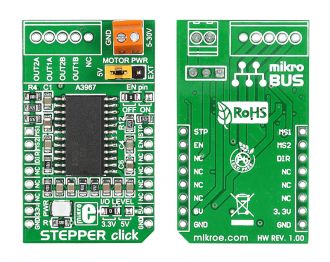
We strongly encourage users to use Package manager for sharing their code on Libstock website, because it boosts your efficiency and leaves the end user with no room for error. [more info]

Rating:
Author: MIKROE
Last Updated: 2018-03-13
Package Version: 1.0.0.1
mikroSDK Library: 1.0.0.0
Category: Stepper
Downloaded: 11281 times
Followed by: 5 users
License: MIT license
Stepper click is a stepper motor driver board in mikroBUS form factor. It features the A3967SLBT microstepping motor driver with a built-in translator.
Do you want to subscribe in order to receive notifications regarding "Stepper click" changes.
Do you want to unsubscribe in order to stop receiving notifications regarding "Stepper click" changes.
Do you want to report abuse regarding "Stepper click".


Library Description
The library carries everything needed for stepper motor control including speed
and acceleration setup. The library is also adjustable to working on different amounts of ticks per second, also speed and acceleration can be provided in float format. The buffer used for movement calculation is defined by the user so this library can be adjusted for MCUs with very limited RAM resources. Check the documentation for more details on how to use it.
Key functions:
Examples Description
The application is composed of three sections:
void applicationTask()
{
stepper_start( (T_STEPPER_OBJ_P)&myStepper );
while( myStepper.status.running )
stepper_process( (T_STEPPER_OBJ_P)&myStepper );
Delay_ms( 2000 );
stepper_start( (T_STEPPER_OBJ_P)&myStepper );
Delay_ms( 1000 );
stepper_stop( (T_STEPPER_OBJ_P)&myStepper );
Delay_ms( 2000 );
}
In addition to the library function calls example carries the necessary Timer ISR and Timer initialization. Check the Timer initialization settings and update it according to your MCU - Timer Calculator.
Additional notes and information
Depending on the development board you are using, you may need USB UART click, USB UART 2 click or RS232 click to connect to your PC, for development systems with no UART to USB interface available on the board. The terminal available in all MikroElektronika compilers, or any other terminal application of your choice, can be used to read the message.